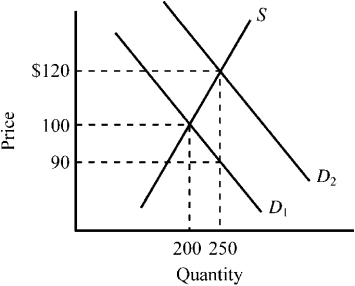Use the figure below to answer the following question(s) .
Figure 4-12

-Refer to Figure 4-12.The supply curve S and the demand curve D₁ indicate initial conditions in the market for college textbooks.A new government program is implemented that grants students a $30 per textbook subsidy on every textbook they purchase,shifting the demand curve from D₁ to D₂.Which of the following is true for this subsidy given the information provided in the exhibit?
Definitions:
Amphibians
A group of cold-blooded vertebrates characterized by their ability to live both in water and on land, undergoing metamorphosis from a larval stage to an adult.
Carboniferous
A geologic period and system that extends from the end of the Devonian Period, about 359.2 million years ago, to the beginning of the Permian Period, about 299 million years ago.
Reptiles
Cold-blooded vertebrates that breathe air, usually lay eggs, and have scales covering their bodies, including snakes, lizards, crocodiles, and turtles.
Chordates
Deuterostome animals that, at some time in their lives, have a cartilaginous, dorsal skeletal structure called a notochord; a dorsal, tubular nerve cord; pharyngeal slits; a postanal tail; and an endostyle (or its derivative, a thyroid gland).
Q4: In which of the following markets are
Q47: Which of the following would be a
Q64: Refer to Figure 4-22.Suppose the same S
Q70: A decrease in demand will cause<br>A)an increase
Q137: Which of the following is true regarding
Q141: Refer to Figure 4-24.The equilibrium price before
Q175: Which of the following would be most
Q248: Refer to Figure 4-11.On the Laffer curve
Q251: If the supply of health care services
Q278: Refer to Figure 4-19.When the price ceiling